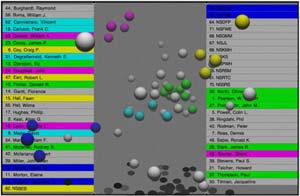Communications Media
Engineering and research-driven innovations in the field of communications are addressed here, in addition to business developments in the field of media-wide communications.
innovations-report offers informative reports and articles related to interactive media, media management, digital television, E-business, online advertising and information and communications technologies.

Simulation software beats traditional approach in online course
Students in an online class who learned networking through a commercially available simulation scored higher and retained more course information than students taught with a traditional network-diagramming software package, says a Penn State researcher.
“Those students also demonstrated better understanding of the networking concepts and indicated they spent more time on course assignments,” said Brian Cameron, instructor in Penn State’s School of Information Sciences and Technology (I

Impatient web searchers measure web sites’ appeal in seconds
Web users are picky and impatient, typically visiting only the first three results from a query, with one in five searchers spending 60 seconds or less on a linked Web document, according to Penn State researchers.
“People make instantaneous judgments about whether to stay on a site, and if a site doesn’t the give the right impression, users will bypass it,” said Dr. Jim Jansen, assistant professor in Penn State’s information sciences and technology (IST). “A page has to be well-d

A ‘butler’ in your mobile phone
University of Southampton scientists create a computer agent that aims to make life less complicated
A new computer agent that will work through users’ mobile phones and organise their business and social schedules, has been developed by scientists at the Department of Electronics and Computer Science (ECS) at the University of Southampton.
The agent is an example of how the next generation of World Wide Web will work. An artificial intelligence programme has been devised which a

Navigating the e-mail labyrinth
Researchers at the University of Southern California have created a new tool for organizing and visualizing collections of electronic mail. It is designed to help legal researchers, historians, archivists, and others faced with challenges in dealing with large email archives.
For examples, consider the following cases:
* A large corporation has just received a subpoena for all email messages on a specific question. Traditional keyword searches return an enormous volume of ma

New virtual reality array allows immersive experience without the disorienting 3-D goggles
The University of Pennsylvania has installed a virtual reality system that allows a participant full-body interaction with a virtual environment without the hassle of bulky, dizzying 3-D glasses. The system will be demonstrated for journalists and others Thursday, May 15.
Key to the installation, dubbed LiveActor, is the pairing of an optical motion capture system to monitor the body’s movements with a stereo projection system to immerse users in a virtual environment. The combination

For best results, stick to one search engine
Web users who stick to one or two search engines and learn those well will have better results for their queries than users who try the same query or various engines, a Penn State researcher says.
“There are no wholesale rules about structuring a query that will work on multiple search engines,” said Bernard J. Jansen, assistant professor of information sciences and technology (IST). “And what works on one engine, such as narrowing a query, can have the opposite effect on other search engine